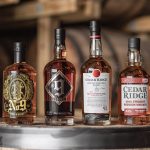The Only Craft Distillery in America to be a State’s #1 Overall Best Selling Whiskey: How Did They Do It?

In forty-nine states a major distillery produces the #1 best-selling bourbon in the state. In many cases this is Jim Beam or Maker’s Mark or Evan Williams or often Jack Daniel’s if you count that as a bourbon (I do). But that is not the case in Iowa where a craft bourbon first released in […]
The post The Only Craft Distillery in America to be a State’s #1 Overall Best Selling Whiskey: How Did They Do It? first appeared on The Bourbon Review.
